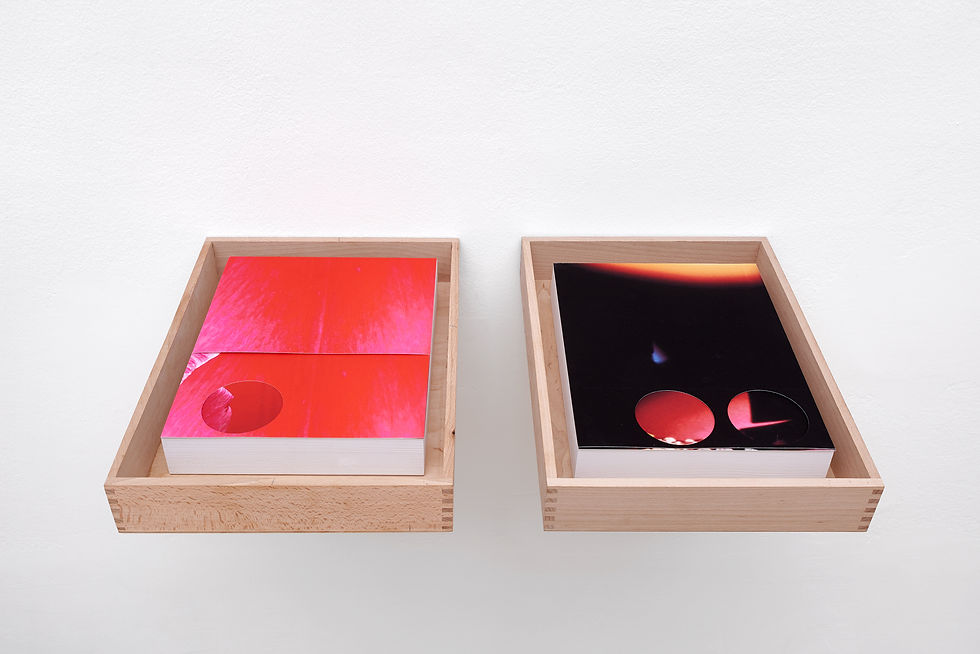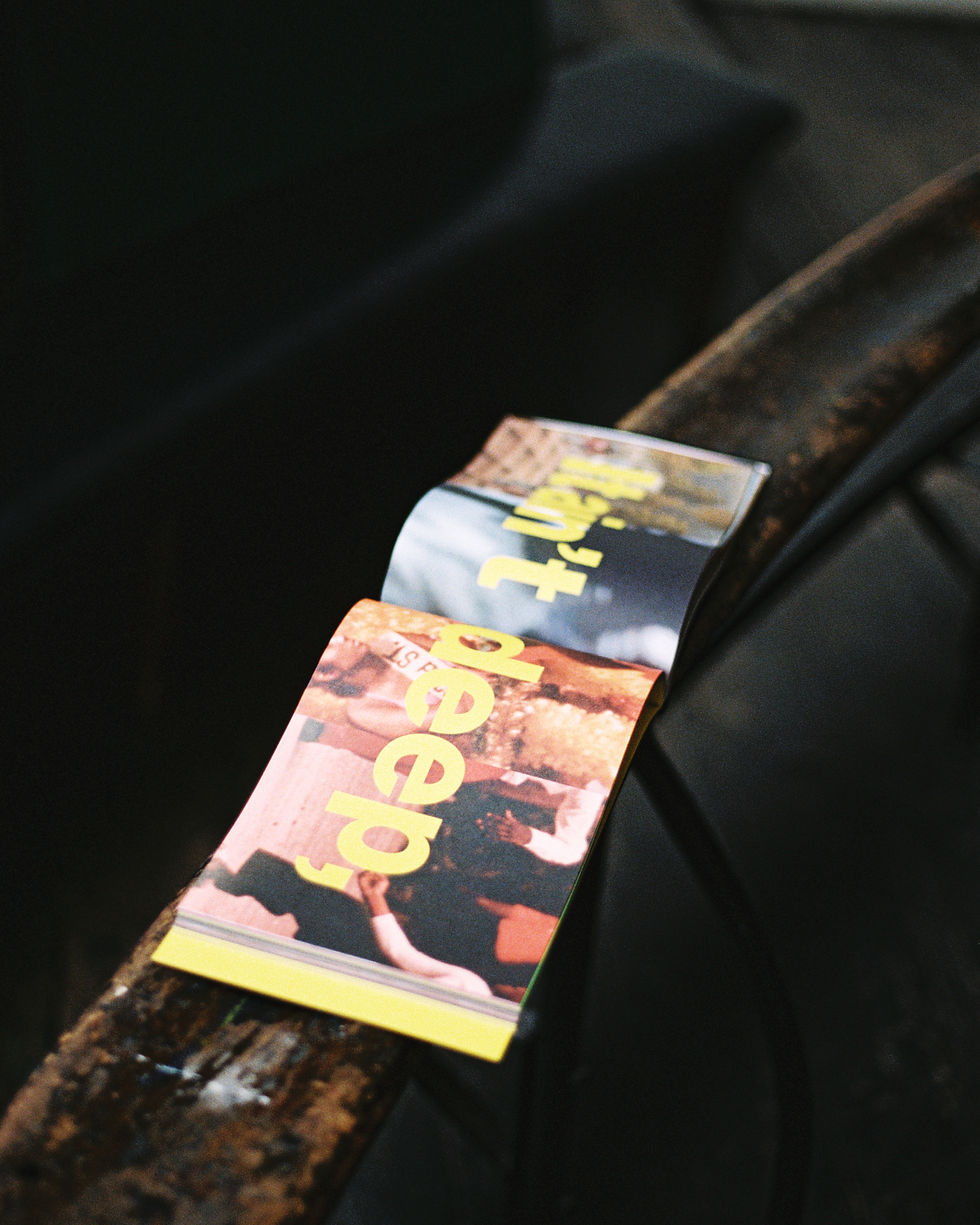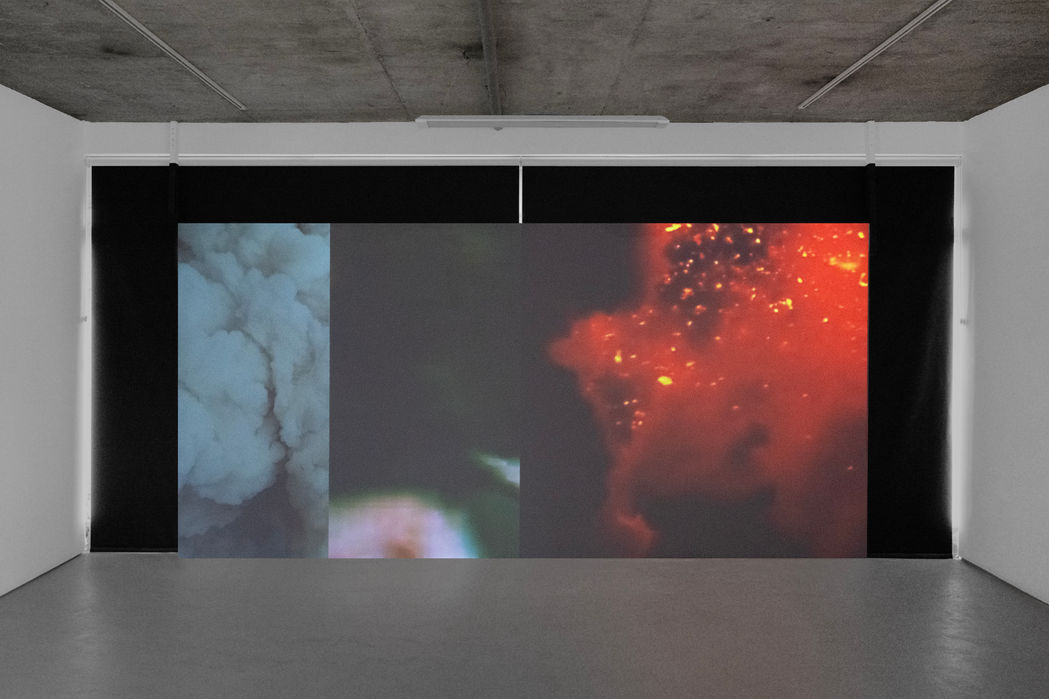Born 1995, Lomé, TOGO
Lives and works in London
The TEETH KISSIN’ series emerges from a practice that is deliberately medium non-specific, drawing on publication, performance, moving image, photography, poetry, and archival research. The series adopts a research-led methodology that treats the archive as a site of inquiry and disruption. Through collage, fragmentation, and reordering, the works insist on the necessity of artistic intervention within the archive: an act of reframing that becomes a way of negotiating visibility—probing how Black life has been documented, misrepresented, or erased by unsettling the expectations that shape how we read, consume, or recognise the Black image.
Rather than accepting the archive as fixed, the TEETH KISSIN’ series engages with it as something porous, contested, and cyclical. The shifting relationships between text, voice, and image open spaces for conversation and introspection, foregrounding lived experience over institutional authority. Across the series, memory becomes a form of knowledge; imagination becomes a tool for survival; and the poetic becomes a method for holding complexity and tenderness. Through these gestures, the TEETH KISSIN’ series carves out spaces for reclamation—spaces shaped by intimacy, resistance, and the ongoing process of DIS-membering / RE-membering.
2025

The Weight of Remembering, 2025. Walnut, recycled paper, text 25 x 32 x 150 cm

The Weight of Remembering, 2025 (Details)
Archival material:
“An artist’s duty, as far as I am concerned, is to reflect the times. I think that is true of painters, sculptors, poets, musicians, I – as far as I am concerned, it’s their choice. But I choose to reflect the times and the conditions in which I find myself. That, to me, is my duty. And at this crucial time in our lives, when everything is so desperate, when every day is a matter of survival, I don’t think you can help but be involved. Young people, black and white, know this– that’s why they’re so involved with politics. We will shape and mold this country, or it will not be molded and shaped at all anymore. So I don’t think you have a choice — how can you be an artist and not reflect the times? That, to me, is the definition of an artist.”
– Nina Simone, Interview with Black Journal,1969
Page from Myths and Legends of Ancient Egypt by Lewis Spence. First edition. Published by George G. Harrap & Co. Ltd., London, 1915. Photographed by the artist on November 28, 2024, during a visit to Henry Pordes Books Ltd, United Kingdom, accompanied by pianist/composer Karya Sezener and philosopher/master of tarot Ayse Sezener, 2025. Ink jet print on photographic paper, aluminium stainless sheet, 25 x 19 cm
Refracted Light through a Prism. Image source unknown; originally found in an article by Abdur Rahman Mahdi on racism in the Judeo-Christian tradition. The image has been slightly altered by the artist, 2025. Ink jet print on photographic paper, aluminium stainless sheet, 25 x 19 cm

Solo Exhibition NAVIGATOR presented at Nicoletti Contemporary, 2025

Studies on Opacity: What The Light Remembers, 2025, UV sublimation on wood, 100 x 212 cm

Solo Exhibition NAVIGATOR presented at Nicoletti Contemporary, 2025


Right: The sun will rise and the sea will ripple with waves so deep, 2025, Photographic collage, Giclée print on Hahnemühle Bamboo mounted on aluminium, aluminium subframe, 24 x 30 cm; Left: Star, 2025, Photographic collage, Giclée print on Hahnemühle Bamboo mounted on aluminium, aluminium subframe, 24 x 30 cm
2024
In ashes a multitude of dreaming(s); unruly - immaterial is the archive, 2024, Archival drawer, glass vitrine, bamboo paper, ash, charcoal, alabaster, Black paint 4.0, 10 x 100 x 50 cm (drawer) / 24,5 cm (foot length)
I wore your tongue so loud against me, 2024, silent film, single-channel video loop, 04:45 mins; Presented at Public Gallery, 2024 and 198 Contemporary Arts and Learning, 2025


Right: Provenance, Obselete 2024, Image: Giclée, Torchon Matt Archive Paper Clouded Mould Feel, 80x40cm; Script: Laser Print, Recycled Paper, 20x40cm, White Box Frame, Anti-Reflective Glass; Left: AMONGST THE STARS AGAIN 2023, Single-channel video, 02:30 mins, Credits: A Film by Divine Southgate-Smith

Solo Exhibition What I've Been Doing Lately presented at CEU Open Gallery, organised & supported by the British Council, as a part Photo Festival, 2024
Archival material:
1. Show my teeth; I say nothing (2024), Unknown: Jamaica; 1940 [Photograph] Jamaican Agriculture, National Archives, Caribbean Through a Lens project; courtesy of The National Archive; Tony Hammond: Unknown; Unknown; Getting Up Close and Personal With a Tulip; Taken in our garden this spring [Photograph] Flicker; 2. Show my teeth; I say nothing (i) (2024), Samuel Daniell: Chertsey; 1775-1811. (1804) A Kaffer village; Native village and watering hole. [Aquatint] Image is taken from A collection of plates illustrative of African scenery and animals, with descriptive letterpress; Project: General Dundas's expedition in South Africa 180; copyright unknown; courtesy of The British Library; Unknown: Bruxelles; [Photograph] Zargourski, Archives Pierre Loos, Bruxelles - superimposed image unknown - copyright unknown; 3. Show my teeth; I say nothing (ii) (2024), John H. White: Lexington, North Carolina; 1945. (August 1973) Black Beauties With Colourful Hair Grace A Float During The Annual Bud Billiken Day Parade [Photograph] National Archives, Records of the Environmental Protection Agency; Project: DOCUMERICA; courtesy of The National Archive; John H. White: Lexington, North Carolina; 1945. (August 1973) Artist Ron Blackburn Painting An Outdoor Wall Mural At The Corner Of 33rd and Giles Street In Chicago [Photograph] National Archives, Records of the Environmental Protection Agency; Project: DOCUMERICA ; courtesy of The National Archive.

Solo Exhibition What I've Been Doing Lately presented at CEU Open Gallery, organised & supported by the British Council, as a part Photo Festival, 2024

The rest is…Silence, 2024, Giclée, Photographic collage, Photo Rag Metallic Hahnemühle archival baryta mounted with Metal Lever Arch File Clips, 100cm x 130cm
Archival material:
The rest is…Silence (2024); 1. Unknown: Unknown; Unknown; An earring made of film scans, ‘Ça veut dire?’, No Known Origin, Object was found on the streets of Paris and recycled into a pair of earrings, I paid 8.00 EUR [Photograph] Scanned by Pelumi Sokunbi 2023; courtesy of Divine Southgate-Smith; 2. A Still of an African Woman walking by, smiling: Sans Soleil; directed by Chris Marker; written by Chris Marker (as Sandor Krasna)1; documentary; distributed by Argos Films; narrated by Florence Delay (French version); running time 100 minutes (1983) France; Extract [00:34:04 - 00:34:05]

Right: READING IN-BETWEEN SPACES 2023, Giclée, Photographic collage, Hahnemühle Bamboo mounted on Aluminium with Aluminium, Subframe, 53cm x 61cm; Center: ‘Ça Veut Dire?’ 2024, Collage, Large Format Print, Vinyl, Size Variable; Left: I tried to recall, recall 2024, Giclée, Photographic collage, Hahnemühle Bamboo mounted on gesso primed board 24cm x 30cm; I tried to recall, I tried, 2024, Giclée, Photographic collage, Hahnemühle Bamboo mounted on gesso primed board, 24cm x 30cm
Archival material:
Right: READING IN-BETWEEN SPACES (2023); 1. John H. White: Lexington, North Carolina; 1945. (August 1973) Black Beauties With Colorful Hair Grace A Float During The Annual Bud Billiken Day Parade [Photograph] National Archives, Records of the Environmental Protection Agency; Project: DOCUMERICA; courtesy of The National Archive; 2. Samuel Daniell: Chertsey; 1775-1811. (1804) A Kaffer village; Native village and watering hole. [Aquatint] Image is taken from A collection of plates illustrative of African scenery and animals, with descriptive letterpress; Project: General Dundas's expedition in South Africa 180; copyright unknown; courtesy of The British Library; Center: ‘Ça Veut Dire?’ (2024); 1. John H. White: Lexington, North Carolina; 1945. (August 1973) Black Beauties With Colourful Hair Grace A Float During The Annual Bud Billiken Day Parade [Photograph] National Archives, Records of the Environmental Protection Agency; Project: DOCUMERICA; courtesy of The National Archive; 2. Samuel Daniell: Chertsey; 1775-1811. (1804) A Kaffer village; Native village and watering hole. [Aquatint] Image is taken from A collection of plates illustrative of African scenery and animals, with descriptive letterpress; Project: General Dundas's expedition in South Africa 180; copyright unknown; courtesy of The British Library; 3. Unknown: Unknown; Unknown; An earring made of film scans, ‘Ça veut dire?’, No Known Origin, Object was found on the streets of Paris and recycled into a pair of earrings, I paid 8.00 EUR [Photograph] Scanned by Pelumi Sokunbi 2023; courtesy of Divine Southgate-Smith Left: I tried to recall, recall (2024); Tony Hammond: Unknown; Unknown; Getting Up Close and Personal With a Tulip; Taken in our garden this spring [Photograph] Flicker; I tried to recall, I tried (2024); John H. White: Lexington, North Carolina; 1945. (October 1973) Black Soul Singer Isaac Hayes Performs At The International Amphitheater In Chicago [Photograph] National Archives, Records of the Environmental Protection Agency; Project, DOCUMERICA; courtesy of The National Archive.

Right: I tried to recall, recall 2024, Giclée, Photographic collage, 24cm x 30cm, Hahnemühle Bamboo mounted on Aluminium with Aluminium, Subframe; Left: I tried to recall, I tried 2024, Giclée, Photographic collage, 24cm x 30cm, Hahnemühle Bamboo mounted on Aluminium with Aluminium, Subframe
2023

‘‘...COMME UN JOUR’’, 2023 Collage of research, Laser Print, Recycled Paper, Metal Clip, Size variable
"Tomorrow Is My Turn", is the English version of "L'Amour, c'est comme un jour" (1962) a song by Charles Aznavour. Written by Marcel Stellman for Nina Simone, the song was recorded by Nina Simone on her 1965 album I Put a Spell on You.
![Divine Southgate-Smith - TEETH KISSIN' - Soup Gallery [5].jpg](https://static.wixstatic.com/media/af2d26_980dc55730d34a5eb9f2a96280727eeb~mv2.jpg/v1/fill/w_980,h_654,al_c,q_85,usm_0.66_1.00_0.01,enc_avif,quality_auto/Divine%20Southgate-Smith%20-%20TEETH%20KISSIN'%20-%20Soup%20Gallery%20%5B5%5D.jpg)
TEETH KISSIN’” at Soup Gallery, London, 2023
![Divine Southgate-Smith, FOR TOMORROW, 2023 [1]_edited.jpg](https://static.wixstatic.com/media/af2d26_e36dbe9fbe9f498f82a2dfabe30b1909~mv2.jpg/v1/fill/w_980,h_1307,al_c,q_85,usm_0.66_1.00_0.01,enc_avif,quality_auto/Divine%20Southgate-Smith%2C%20FOR%20TOMORROW%2C%202023%20%5B1%5D_edited.jpg)
‘‘FOR TOMORROW’’, 2023 Archival digital collage, Inkjet, EPSON Matt Photo Paper, Metal Binder, 100cm x 160cm
Archival material:
‘‘FOR TOMORROW’’ (2023); 1. John H. White: Lexington, North Carolina; 1945. (August 1973) Minority Youngsters Who Gathered To Have Their Picture Taken On Chicago's South Side During A Community Talent Show [Photograph] National Archives, Records of the Environmental Protection Agency; Project, DOCUMERICA; courtesy of The National Archive; 2. John H. White: Lexington, North Carolina; 1945. (August 1973) Black Beauties With Colorful Hair Grace A Float During The Annual Bud Billiken Day Parade [Photograph] National Archives, Records of the Environmental Protection Agency; Project: DOCUMERICA; courtesy of The National Archive; 3. John H. White: Lexington, North Carolina; 1945. (June 1973) Black Sidewalk Salesmen Arranging Their Fresh Fruits And Vegetables On Chicago's South Side [Photograph] National Archives, Records of the Environmental Protection Agency; Project: DOCUMERICA; courtesy of The National Archive.

TEETH KISSIN’” at Soup Gallery, London, 2023
"WHAT I'VE BEEN DOING LATELY" 2023, explores archival imagery as a potent source of poetic utterance. Combining photographic, musical, and literary references, Southgate-Smith’s compositions capture fragments of black experiences with multi-sensory resonance, allowing viewers to engage with the deliberate interventions both intellectually and emotionally. The series’ title is borrowed from Jamaica Kincaid’s 1981 short story, featuring an introspective narrative and a protagonist recounting moments from her life that blur the line between memory and imagination. Southgate-Smith aims to embody a similar approach to storytelling, where historical and cultural anchors, alongside the creative potential of archives, are used to visually convey the collective complexities and realities of the black experience. Much of the original imagery for the series is sourced from John H. White’s photographic series Portrait of Black Chicago, which resides within the National Archives and Records Administration (United States). Originally commissioned as part of the Environmental Protection Agency’s DOCUMERICA project, White was assigned to document “subjects of environmental concern” on the South Side of Chicago in 1973–74, but instead found a resilient community of Black residents facing difficult circumstances with “spirit, love, zeal, pride and hope.”
Archival material:
1. READING IN-BETWEEN SPACES (2023); 1. John H. White: Lexington, North Carolina; 1945. (August 1973) Black Beauties With Colorful Hair Grace A Float During The Annual Bud Billiken Day Parade [Photograph] National Archives, Records of the Environmental Protection Agency; Project: DOCUMERICA; courtesy of The National Archive; 2. Samuel Daniell: Chertsey; 1775-1811. (1804) A Kaffer village; Native village and watering hole. [Aquatint] Image is taken from A collection of plates illustrative of African scenery and animals, with descriptive letterpress; Project: General Dundas's expedition in South Africa 180; copyright unknown; courtesy of The British Library; 2. TOMORROW IS MY TURN (2023); 1. John H. White: Lexington, North Carolina; 1945. (August 1973) Black Beauties With Colorful Hair Grace A Float During The Annual Bud Billiken Day Parade [Photograph] National Archives, Records of the Environmental Protection Agency; Project, DOCUMERICA; courtesy of The National Archive; 2. John H. White: Lexington, North Carolina; 1945. (October 1973) Black Soul Singer Isaac Hayes Performs At The International Amphitheater In Chicago [Photograph] National Archives, Records of the Environmental Protection Agency; Project, DOCUMERICA; courtesy of The National Archive; 3. ‘NEATH THE MANGO TREE (2023); John H. White: Lexington, North Carolina; 1945. (August 1973) Black Family Enjoying The Summer Weather At Chicago's 12th Street Beach On Lake Michigan [Photograph] National Archives, Records of the Environmental Protection Agency; Project, DOCUMERICA; courtesy of The National Archive; 4. OWARE (2023); 1. John H. White: Lexington, North Carolina; 1945. (August 1973) Black Beauties With Colorful Hair Grace A Float During The Annual Bud Billiken Day Parade [Photograph] National Archives, Records of the Environmental Protection Agency; Project: DOCUMERICA; courtesy of The National Archive; 2. Frederic Morellec: France. (30 May 2000) Image of artwork from Galerie CSAO private collection [Photograph] Project: African Style, by Stephanie Guibourge, published by Flammarion; courtesy of Galerie CSAO; 5. WATERING SEEDS (2023); 1. John H. White: Lexington, North Carolina; 1945. (August 1973) Black Beauties With Colorful Hair Grace A Float During The Annual Bud Billiken Day Parade [Photograph] National Archives, Records of the Environmental Protection Agency; Project, DOCUMERICA; courtesy of The National Archive; 2. Richard Earlom: London; 1743-1822. Johan Joseph Zoffany RA: Frankfurt; 1733-1810. (2 December 1802) Tiger Hunting in the East Indies [Mezzotint] Project: British Deputy High Commission, Kolkata, India. Purchased from Colnaghi, April 1952; copyright unknown; courtesy of The British Library.
![Divine Southgate-Smith - TEETH KISSIN' - Soup Gallery [3].jpg](https://static.wixstatic.com/media/af2d26_c561ac6d33484b7d97c8775af96db667~mv2.jpg/v1/fill/w_980,h_653,al_c,q_85,usm_0.66_1.00_0.01,enc_avif,quality_auto/Divine%20Southgate-Smith%20-%20TEETH%20KISSIN'%20-%20Soup%20Gallery%20%5B3%5D.jpg)
WATERING SEEDS, OWARE, READING IN-BETWEEN SPACES, TOMORROW IS MY TURN, Archival digital collage, Giclée, Hahnemühle Bamboo mounted on Aluminium, 53cm x 61cm
2022
MUSOYA (2022) Multi-channel film installation and performance,16:48 mins, Credits: A Film by Divine Southgate-Smith, Performance by Patricia Badin
MUSOYA in conversation with PATRICIA BADIN, 2022. Musoya, a term equating to “femininity” in Bambara (a Malian dialect), is a performance by Patricia Badin (artist and dancer) in collaboration with Divine Southgate-Smith. Drawn from a series of conversations, interviews, and workshops, the performance is an audio-visual re-centring of the Black gaze—a beautifully choreographed collage of Twerk, Afro-Fusion, improvisation, and film. Its staging is intentionally sparse: raw, unembellished, and resistant to spectacle. Here, the filmic element assumes the role of a Dancehall MC, guiding the rhythm, asserting presence, and shaping the narrative voice.
At its core, MUSOYA is a celebration—an embodied declaration—of the Black female body in motion. It is also an inquiry into the layered histories that inform that motion. The performance focuses on the significance of Twerk and its evolution in the Caribbean, most specifically within the Jamaican Dancehall scene. Isolated movement of the hips, pelvis, and abdomen has long been central to various African dance traditions, where such gestures carry social, spiritual, and communal meaning. “Twerk” is a contraction of “twist” and “jerk”—two American dance forms that emerged in the 1960s. The term first reached mainstream audiences with DJ Jubilee’s Do the Jubilee All (1993). Yet the movement itself far predates the terminology. Its origins extend back to pre-colonial African societies, resurfacing across diasporic geographies as a form of embodied memory—one that persisted despite, and sometimes because of, the histories of structural dehumanisation, colonial violence, and cultural suppression that attempted to contain and distort Black expressive forms.
This tension—between memory and erasure, agency and distortion—sits at the heart of MUSOYA. In its contemporary global iteration, twerking is frequently misread through a white-centric gaze: dismissed as hyper-sexual, vulgar, or morally questionable. These judgments are not incidental; they emerge from a longer colonial project that positioned African cultures as pagan, excessive, or inherently sexual. As a result, many Black women encounter a complex relationship to the dance. What might feel instinctive, joyous, or cathartic can instead become laden with shame—a shame often reinforced within Black communities themselves as a means of ensuring survival and respectability for Black women under white scrutiny.
Within this context, the performance asserts twerking as something deeply internal: an act of self-possession rather than exposure; a trance rather than a spectacle. The dance becomes a site of liberation—of returning to the body, to lineage, and to forms of expression that refuse imposed boundaries of propriety. It reveals how Black women’s embodied knowledge has been historically policed, vilified, or extracted, and how movement continues to operate as a quiet yet profound form of resistance.
As Badin reflects:
“In Dancehall, the words are important—they are instructions to the dancers and a reflection of the community’s values and beliefs. Often it can be empowering, but it can also be homophobic and sexist.”
This duality is essential. Dancehall, like many cultural spaces shaped by the Caribbean and wider African diaspora, holds multitudes: empowerment and constraint, celebration and critique, liberation and contradiction. MUSOYA holds space for these complexities, acknowledging that the dance—and the bodies that carry it—exist within layered and sometimes conflicting cultural realities. The work positions embodiment as a site of knowledge, continuity, and power. It invites us to consider how cultural forms travel, mutate, and endure, and how Black women continue to navigate and negotiate their visibility within systems that both desire and fear their expressive autonomy.
WAKANDA Forever (2022) Single-channel video, 10:45 mins, Credits: A Film by Divine Southgate-Smith, Voiced by Kobby Adi and Performed Live by Tafari Alleyne
WAKANDA Forever (2022) is an audiovisual work composed from a selection of ethnographic moving-image material. The film is a translation of my poem But It Comes Out Mad, originally written in 2019 during my first year at the Royal Academy of Arts and titled after Camille Yarbrough’s song of the same name.
Poetry serves as both score and counterpoint in the work, offering a rhythmic, emotional, and political grounding for the visuals. In performance contexts, the work can be experienced in two forms: with an audio recording of the poem, or as a live performance in which the performer sits within the audience whilst the film plays silently, accompanied only by subtitles. This spatial arrangement collapses the distance between performer and viewer, amplifying the intimacy of the spoken word and foregrounding the relationship between voice, body, and image.
Using archival footage drawn from multiple sources, the film constructs a shifting visual language that deliberately cuts, layers, juxtaposes, and interrupts the frame. Through these gestures, the work positions the archival record as a contested space—one that can be disrupted, re-voiced, and reconfigured through poetic intervention.

TEETH KISSIN' Where Elephants Reside, 2022 at Royal Academy Schools, London
TEETH KISSIN’: Where Elephants Reside (2022) is an adaptation of original poetry written between 2019 and 2021. The book brings together photographs drawn from multiple archives alongside my own images, assembling a sequence of collages integrated with text. The publication is conceived as a site for conversation—where reading becomes an active encounter: a performance in which memory, emotion, and resistance come into view through dialogue and community.
There are many nuances to “kissing your teeth,” a non-verbal gesture that, since childhood, has enabled me to confidently object, agree, poke fun, and even show love. Widely used across Black and Brown communities, this intimate communication tool carries a range of meanings shaped by context and relationship. Whether political or personal, intimate or communal, the gesture holds a complexity that language often cannot capture. In this sense, it becomes a metaphor for the book’s approach to memory and communication.
The publication approaches poetry as a form of archiving. Rather than recording events in the manner of institutional archives, poetry is emotional, sensory, and imaginative. It links history to memory, memory to imagination, and imagination to transformation. Through this movement, poetry becomes an act of resistance—offering a counter-archive that privileges lived experience over institutional authority. It makes room for contradictions, tenderness, longing, and opacity: the kinds of truths we embody.
Collage, in this sense, becomes a literary and visual strategy that reinforces this resistance. Zooming, cropping, and the use of subtitles become tools for questioning how histories are constructed and who they serve. By altering and recontextualising these photographs, the work unsettles the presumed neutrality of the archive and exposes the gaps and distortions embedded within it. The resulting images are fragmented yet intentional, mirroring the rhythms of the poetry and the layered nature of memory itself.
Where Elephants Reside ultimately proposes the publication as a space for storytelling and healing. Through the interplay of text and image, the book invites readers to consider how personal and collective histories are carried, altered, and reimagined. It offers an alternative mode of remembrance—one grounded in the embodied knowledge of those whose experiences have long been marginalised or misrepresented within official records.















































